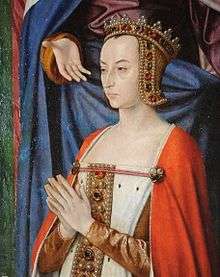Surcoat
A surcoat or surcote initially was an outer garment commonly worn in the Middle Ages by both men and women in Western Europe. It can either refer to a coat worn over other clothes or the outermost garment itself. The name derives from French meaning "over the coat", a long, loose, often sleeveless coat reaching down to the feet.[1]

History
Men's surcoat
From about the 12th century, knights wore long, flowing surcoats, frequently emblazoned with their personal arms, over their armor. These usually extended to about mid-calf, had slits in the bottom front and back, allowing the wearer to ride comfortably, and were either sleeved or sleeveless. Historians believe that the practice of wearing white surcoats was adopted during the Crusades, their main purpose being to reflect the direct sun, which overheated the armour (and the soldier inside) – although it may be argued that here its color would have been of little help, while in poor weather they helped keep rain and the muck of battle away from the easily corroded mail links. The surcoat displayed the device of the knight (origin of the term "coat of arms"), thereby identifying him, which in turn, combined with the increased use of the great helm (late 12th century, early 13th century), became an essential means of recognition. Indeed, some historians cite this as one of the reasons behind the spread of heraldry across medieval Europe. During the 13th century, knights began to add plates of armour to their surcoats, subsequently giving rise to the medieval coat of plates. In the early fourteenth century, the front of the knight's surcoat was shortened so that it was longer at the back and knee-length at the front, allowing greater freedom of movement and eliminating the danger of a rider getting his spurs caught in the garment. By the mid-fourteenth century, it was replaced with the "jupon" (or "gipon"), a much shorter item, often padded for supplementary protection.[2]
In the 15th century, once suits of plate armour became common, the surcoat was phased out of use. This period in the history of armour development, in which surcoats became increasingly rare, is referred to as the "surcoatless period" (1420-1485).
Women's surcoat
Women began wearing surcoats during the 13th century, both with and without sleeves.[3] A particular style, known as the sideless surcoat, developed as a fashion in the 14th century. This was a sleeveless, floor-length garment featuring exaggerated armholes, which at their most extreme were open from shoulder to hip, revealing the gown underneath. The narrow strip covering the torso, known as the plackard,[4] was usually no more than a foot wide. The style drew criticism from some moralists, who thought the garment drew an inappropriate amount of attention to the female body.[3] Despite this, sideless surcoats continued to be worn as ceremonial dress well into the 15th century, long after they had ceased to be fashionable. Some estimates place them being worn as state apparel as late as 1525.[4]
Gallery
 c. 1300-1310
c. 1300-1310 An early example of a sideless surcoat, c. 1325-1335
An early example of a sideless surcoat, c. 1325-1335 A sideless surcoat with gaping armholes, late 14th century
A sideless surcoat with gaping armholes, late 14th century_detail.jpg) Sideless surcoat edged with ermine, c. 1460
Sideless surcoat edged with ermine, c. 1460 A furred, embellished surcoat worn for ceremonial purposes, 1489-1499
A furred, embellished surcoat worn for ceremonial purposes, 1489-1499
Footnotes
- Nunn, pp. 14, 23, 24, 28
- Farr, E.; et al. (1873). The National History of England. 1. London & Glasgow: William Collins, Sons & Company. Retrieved 2011-04-06.
- Newman, Paul B. (2001). Daily Life in the Middle Ages. McFarland. pp. 115–116. ISBN 9780786450527.
- Cumming, Valerie; Cunnington, C. W.; Cunnington, P. E. (2010). The Dictionary of Fashion History. Berg. p. 186. ISBN 9780857851437.
Sources
- Nunn, Joan, Fashion in costume, 1200-2000, New Amsterdam Books, 2000, ISBN 1-56663-279-X
